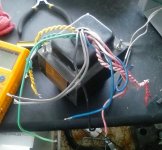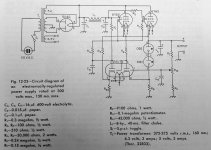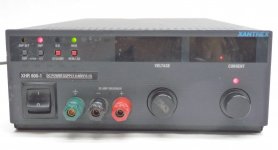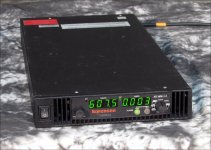Was going to knock up a SE garage amp from 6GV8s I have on hand but I think I may build a Bench Supply first as it will probably come in handy for other projects. Other than the 120V PT for the garage amp I have only one truly high voltage PT. I was saving it for an amp but since it is only rated for about 120-125mA on the B+ winding it might be marginal for a lot of stereo PP applications I may use it for the bench supply instead since one normally prototypes just a single channel and if I do overload it in the bench supply application it would be for a very short time.
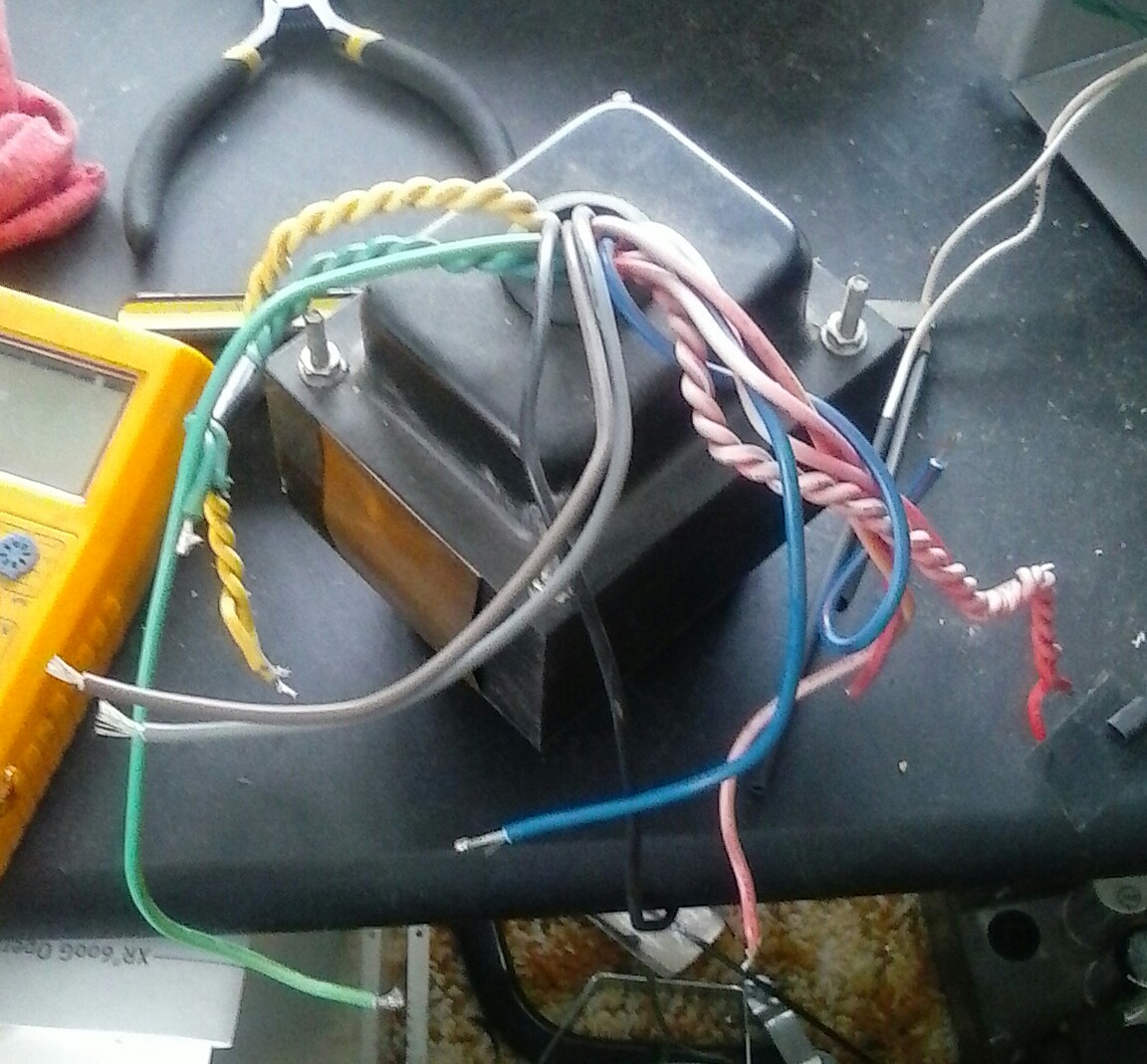
The center tapped B+ winding has full voltage tap and a lower voltage tap (maybe intended for screen supply or just for lower voltage option) on the same winding. on one leg of the B+ winding there is also a lower voltage tap for a bias supply. The bias tap is only on one side of the CT. Not sure whether I should use those lower B+ taps to provide a second output for screen supplies or whether to use it for range selection and use a separate transformer to make a screen supply output. Since it is on only one side I would have to be sure that a bias output was not loaded very much to prevent asymmetry on the B+ outputs.
It has a 5V heater winding and a 6V heater winding. It appears that there are three taps on the primary (blue. gray and brown) which I suspect are 240, 120 and 100 (Japan). I suspect I could use any of the primaries to choose different voltage output ranges so as not to over stress the pass tubes but if I do so I would not be able to use the heater windings for the tubes in the supply. Of course the same would apply for using a variac to reduce voltage range.
If I use separate trannies for heaters I could connect the 5V and 6V windings in series to provide a regulated DC heater supply output (max 7V or so).
The chassis has 3 octal and 3 9 pin mini sockets. I figure on using 1 octal for the screen supply output pass tube and the other two for parallel pass tubes for the main B+ output. The 9 pins can be used for error amplifier tubes and bias supply pass tube. I also have a few 9 and 12 pin compactron sockets that fit where the octals are so if I need to I can use some of those tubes for pass tubes.
Possible pass tubes on hand:
6JS6C (1)
6JB6 (1)
6JN6 (1)
6L6 (2 Used)
6W6GT (1)
6LQ6 (3)
6LU8 (lots)
17JM6A (1)
17JN6 (1)
33GY7A (1)
36KD6 (1)
38HE7 (1)
22JF6 (1)
I could start with the 6LQ6s and if they prove to be in good condition I could sell them and use the proceeds to get some other less expensive tubes for this and use the remainder for some iron or other goodies. 😀
As always thoughts welcomed.
The center tapped B+ winding has full voltage tap and a lower voltage tap (maybe intended for screen supply or just for lower voltage option) on the same winding. on one leg of the B+ winding there is also a lower voltage tap for a bias supply. The bias tap is only on one side of the CT. Not sure whether I should use those lower B+ taps to provide a second output for screen supplies or whether to use it for range selection and use a separate transformer to make a screen supply output. Since it is on only one side I would have to be sure that a bias output was not loaded very much to prevent asymmetry on the B+ outputs.
It has a 5V heater winding and a 6V heater winding. It appears that there are three taps on the primary (blue. gray and brown) which I suspect are 240, 120 and 100 (Japan). I suspect I could use any of the primaries to choose different voltage output ranges so as not to over stress the pass tubes but if I do so I would not be able to use the heater windings for the tubes in the supply. Of course the same would apply for using a variac to reduce voltage range.
If I use separate trannies for heaters I could connect the 5V and 6V windings in series to provide a regulated DC heater supply output (max 7V or so).
The chassis has 3 octal and 3 9 pin mini sockets. I figure on using 1 octal for the screen supply output pass tube and the other two for parallel pass tubes for the main B+ output. The 9 pins can be used for error amplifier tubes and bias supply pass tube. I also have a few 9 and 12 pin compactron sockets that fit where the octals are so if I need to I can use some of those tubes for pass tubes.
Possible pass tubes on hand:
6JS6C (1)
6JB6 (1)
6JN6 (1)
6L6 (2 Used)
6W6GT (1)
6LQ6 (3)
6LU8 (lots)
17JM6A (1)
17JN6 (1)
33GY7A (1)
36KD6 (1)
38HE7 (1)
22JF6 (1)
I could start with the 6LQ6s and if they prove to be in good condition I could sell them and use the proceeds to get some other less expensive tubes for this and use the remainder for some iron or other goodies. 😀
As always thoughts welcomed.
Attachments
Quite a lot of effort goes into building a good variable HV PSU. I wouldn't expend that amount of effort unless the final product had some pretty serious voltage/current capabilities -- e.g. at least 500V and 200~300mA. Even then, it's awfully tempting to throw money at that problem so I can focus on more interesting ones.
You might want to look at just picking up a heath kit hv power supply. I use one of those as my bench supply and it works quite well.
I see the wisdom in that but since I have virtually no money and I do have parts I might make a stab at it anyway since it might be useful, it can be disassembled later and all parts reused, and I might learn a few things along the way. Seems like all I have to lose is time. 🙂
Looks hard to beat: $15 + check the shipping, heavy
ISCO Electrophoresis DC Power Supply Model 494 | eBay
ISCO Electrophoresis DC Power Supply Model 494 | eBay
I rang out the windings this evening and got the following RMS voltages ref to CT:
Input Black and Gray: Main 178V, Screen 137V, Bias 24V
Input Black and Blue: Main 322V, Screen 261V, Bias 46V
Input Black and Brown: Main 386V, Screen 314V, Bias 56V
So pretty good range of voltages.
Input Black and Gray: Main 178V, Screen 137V, Bias 24V
Input Black and Blue: Main 322V, Screen 261V, Bias 46V
Input Black and Brown: Main 386V, Screen 314V, Bias 56V
So pretty good range of voltages.
Thanks Mike. That is very similar to what I have in mind. I plan to use sand rectification and zener reference. Is it high gain that one wants in the error amplifier? Have seen the reference in various locations also so wondering why one would choose one location over another? Was envisioning zener in cathode of error amp. Wonder if mu stage errod amp would have any advantage over tandem as used here.
Desired error amp gain is much like that of any feedback amplifier. More gain increases output accuracy, but it also pushes you toward oscillation. If you deviate from a published design, be prepared to test it thoroughly. Power supply stability is generally tested by stepping the load between two values and monitoring the output as well as internal nodes with a scope. One of the complicating factors is that most of us want the PSU to tolerate large capacitive loads, which put a drag on output slew rate and delay the feedback signal. That can cause the error amplifier to misbehave or even saturate. There are ways to deal with this, but the point I'm trying to make is that PSU design has its subtleties.
Agree with Smoking-Amp. It will be very expensive and time consuming to build a bench supply. Keep in mind that a bench supply is subject to errors in your prototypes so it has to be well protected against shorts and all sorts of other accidents. And hopefully protect your circuits as well, i.e. adjustable current limiting.
As suggested, copy an existing design with minimal changes. The gain of the error amp is one piece of the puzzle that determines the stability of the power supply. Any new design should be analyzed for gain and phase margin. I have a paper design with LT spice simulations for the BIG one, 0 to 750 volts, 0 to 2 Amps. It is though, completely solid state. I will build it some day to replace the 3 dinosaurs currently on my bench.
For now, I would build something like this. One of the dino's on my bench is this KG-664. I got it used at a hamfest for $25 maybe 20 years ago. It finally died due to being left in an unheated building during last years winter when it hit -12 degrees. I replaced all the electrolytics and it is live again. I routinely overload it to 300 mA or more and often hang a 100 uF motor run cap across the output without issue. It is rated for 200 mA. Leave out two pass tubes for a 100 mA version. Rectification is SS, you can substitute 5 watt zeners for the VR tubes.
Pete Millett has a bigger version with simple current limiting on his web site, schematic attached.
For now, I would build something like this. One of the dino's on my bench is this KG-664. I got it used at a hamfest for $25 maybe 20 years ago. It finally died due to being left in an unheated building during last years winter when it hit -12 degrees. I replaced all the electrolytics and it is live again. I routinely overload it to 300 mA or more and often hang a 100 uF motor run cap across the output without issue. It is rated for 200 mA. Leave out two pass tubes for a 100 mA version. Rectification is SS, you can substitute 5 watt zeners for the VR tubes.
Pete Millett has a bigger version with simple current limiting on his web site, schematic attached.
Attachments
Here's a schematic that might be useful -- from my archive. Unfortunately, I haven't always been good about noting sources. It might have appeared in one of those big Markus books.
I have an ancient Lambda that looks similar. I don't think too many manufacturers used 6Y6's as pass tubes.
I've got a couple of these Kepcos. 0-600 volts at 300 mills. These things are built like tanks and never really die. This one may just need a delay tube. They use 6336's for series pass tubes and 5R4 rectifiers. Yes, it's a boat anchor.
Knight KG-664 $250
(2 pics) Kepco 615B $175
(3 pics) ISCO 494 $15
Heath SP-2717a $115
EICO 1030 $100
Fluke 407D $200
Xantrex XT-250 $110
(2 pics) Kepco 615B $175
(3 pics) ISCO 494 $15
Heath SP-2717a $115
EICO 1030 $100
Fluke 407D $200
Xantrex XT-250 $110
Attachments
-
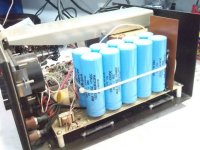 Isco494-b.jpg248.8 KB · Views: 212
Isco494-b.jpg248.8 KB · Views: 212 -
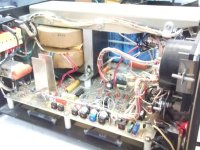 ISCO494.jpg258.1 KB · Views: 533
ISCO494.jpg258.1 KB · Views: 533 -
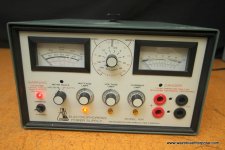 ISCO_494.jpg77.2 KB · Views: 552
ISCO_494.jpg77.2 KB · Views: 552 -
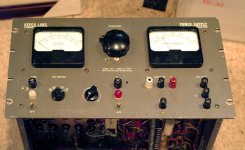 Kepco2.jpg63.8 KB · Views: 538
Kepco2.jpg63.8 KB · Views: 538 -
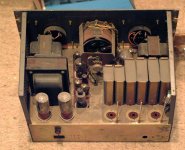 Kepco1.jpg61.5 KB · Views: 610
Kepco1.jpg61.5 KB · Views: 610 -
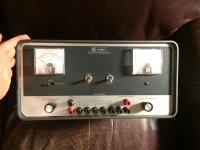 KG-664-1.jpg252 KB · Views: 614
KG-664-1.jpg252 KB · Views: 614 -
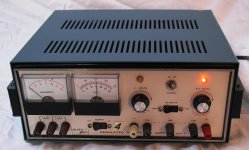 Heath_SP2717.jpg175.4 KB · Views: 263
Heath_SP2717.jpg175.4 KB · Views: 263 -
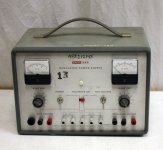 Eico_1030.jpg275.9 KB · Views: 200
Eico_1030.jpg275.9 KB · Views: 200 -
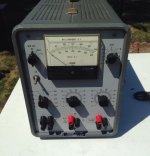 Fluke_407D.jpg69.6 KB · Views: 213
Fluke_407D.jpg69.6 KB · Views: 213 -
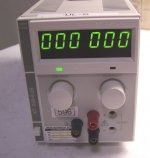 rsz_xantrex_xt-250.jpg161.6 KB · Views: 209
rsz_xantrex_xt-250.jpg161.6 KB · Views: 209
Last edited:
I don't have an ISCO 494 power supply myself (I originally suggested electrophoresis supplies as a possiblility), several members have gotten them. They are a high quality lab supply (34 Lbs, with a big xfmr and likely SCR phase control) (there are newer models with digital readouts and probably HF switchmode design and light weight/compact). The company is still in business, and has provided a complete manual with a schematic to the members who have gotten them.
The electrophoresis type supplies in general may have a ground fault current interrupter (safety) and a minimum load kick-out (no load, no run - safety), which may need over-riding. One unusual feature is Watt limiting, besides current limiting. This could be quite useful for tubes.
Some electrophoresis supplies like Fisher BioTech and E-C Apparatus do not filter to clean DC, but the ISCO is filtered. Maybe someone who has one will chime in. I think someone mentioned the ripple/noise was around 45 mV, but not sure.
A few more HV supplies:
HP 6448B $250 (900 Watt, SCR phase control, heavy xfmr, 60 lbs)
Xantrex XHR-600-1.7 $300 to $1000 lately (used to be $100 a few years ago, HF switch-mode, 600 or 1000 Watt models, 11 lbs, digital readouts, isolated PC digital interface, compact) (this is what I have)
Xantrex XG and XTR 600V book size power supplies, $1000+
And there are a bunch of other newer Lambda, EMS, DCS ... 600V rack mount switching power supplies that can range from $100 to $300 or more.
The electrophoresis type supplies in general may have a ground fault current interrupter (safety) and a minimum load kick-out (no load, no run - safety), which may need over-riding. One unusual feature is Watt limiting, besides current limiting. This could be quite useful for tubes.
Some electrophoresis supplies like Fisher BioTech and E-C Apparatus do not filter to clean DC, but the ISCO is filtered. Maybe someone who has one will chime in. I think someone mentioned the ripple/noise was around 45 mV, but not sure.
A few more HV supplies:
HP 6448B $250 (900 Watt, SCR phase control, heavy xfmr, 60 lbs)
Xantrex XHR-600-1.7 $300 to $1000 lately (used to be $100 a few years ago, HF switch-mode, 600 or 1000 Watt models, 11 lbs, digital readouts, isolated PC digital interface, compact) (this is what I have)
Xantrex XG and XTR 600V book size power supplies, $1000+
And there are a bunch of other newer Lambda, EMS, DCS ... 600V rack mount switching power supplies that can range from $100 to $300 or more.
Attachments
Last edited:
I would take one at that price but it seems to be quite a bit more these days.HP 6448B $250 (900 Watt, SCR phase control, heavy xfmr, 60 lbs)
Here is a "fix-up" HP 6448B for $250. Not that much to them actually. (xfmr, SCR, capacitor, control circuit) But I would get a newer Lambda TCR-600 for cheaper. (same SCR design)
Vintage HP Hewlett Packard DC Power Supply 6448B 0 600V 0 1 5A Powers on Read | eBay
Here is an old HP177A, bid at $14.50 so far, 17 hours to go.
HP 177A Power Supply 0 500 Volt Regulated DC Agilet Keysight | eBay
Lambda TCR-600 fix-up $80
Lambda TCR 600S1 1 D 0813B Power Supply | eBay
Lambda TCR-600 $120 fix-up
Lambda EMI TCR 600S1 1 D 0813B Programmable 600V 1A DC Power Supply Parts Repair | eBay
I used to get the Xantrex XHR-600 supplies as "not working" for $50. Most of them either just needed some configuration DIP switches set on the back, or the current sampling resistor was burned out from a hard "user" short (big cap inside), or they had a custom remote power on mod. Easy fixes. I had one that had a burned through MosFet H bridge side, two Mosfets to replace (not so easy). However, it is hard to get service info for Xantrex, you have to use the IC control chip datasheet. Usually close. A LOT of other circuitry in them besides the main supply though, two micros for the isolated PC interface, A/D and D/A for remote control/monitoring and front panel display, a whole analog isolated interface board, auxiliary supplies to run all those. Never had any problems with other stuff though, except for calibration, lots of pots. Big user manual for setting them up and calibrating.
Then another big manual for programming them remotely. GPIB or RS-232 versions. But I really like the easy front panel interface, ten turn or single turn knobs. I hate some other supplies that have push button numerical programming.
I'm wondering what they will do for the next products beyond the "book size" models. The knobs are so small already on those. Probably verbally talk to the supply.
Vintage HP Hewlett Packard DC Power Supply 6448B 0 600V 0 1 5A Powers on Read | eBay
Here is an old HP177A, bid at $14.50 so far, 17 hours to go.
HP 177A Power Supply 0 500 Volt Regulated DC Agilet Keysight | eBay
Lambda TCR-600 fix-up $80
Lambda TCR 600S1 1 D 0813B Power Supply | eBay
Lambda TCR-600 $120 fix-up
Lambda EMI TCR 600S1 1 D 0813B Programmable 600V 1A DC Power Supply Parts Repair | eBay
I used to get the Xantrex XHR-600 supplies as "not working" for $50. Most of them either just needed some configuration DIP switches set on the back, or the current sampling resistor was burned out from a hard "user" short (big cap inside), or they had a custom remote power on mod. Easy fixes. I had one that had a burned through MosFet H bridge side, two Mosfets to replace (not so easy). However, it is hard to get service info for Xantrex, you have to use the IC control chip datasheet. Usually close. A LOT of other circuitry in them besides the main supply though, two micros for the isolated PC interface, A/D and D/A for remote control/monitoring and front panel display, a whole analog isolated interface board, auxiliary supplies to run all those. Never had any problems with other stuff though, except for calibration, lots of pots. Big user manual for setting them up and calibrating.
Then another big manual for programming them remotely. GPIB or RS-232 versions. But I really like the easy front panel interface, ten turn or single turn knobs. I hate some other supplies that have push button numerical programming.
I'm wondering what they will do for the next products beyond the "book size" models. The knobs are so small already on those. Probably verbally talk to the supply.
Last edited:
Playing the other side of the field for the moment...
There is at least one simple way to make a useful HV bench PSU: Just build out a rectifier/filter system with low impedance, then put a variac in the incoming AC line. The output voltage will be about as stiff as a typical tube amplifier power supply, which can actually be beneficial during circuit development.
One could also argue that a good high-perveance pass tube with its grid tied to a simple variable voltage source, sans error amplifier, will yield PSU regulation similar to a conventional vacuum rectifier hookup -- assuming solid-state rectifiers upstream.
There is at least one simple way to make a useful HV bench PSU: Just build out a rectifier/filter system with low impedance, then put a variac in the incoming AC line. The output voltage will be about as stiff as a typical tube amplifier power supply, which can actually be beneficial during circuit development.
One could also argue that a good high-perveance pass tube with its grid tied to a simple variable voltage source, sans error amplifier, will yield PSU regulation similar to a conventional vacuum rectifier hookup -- assuming solid-state rectifiers upstream.
- Home
- Design & Build
- Equipment & Tools
- Bench Supply
